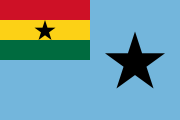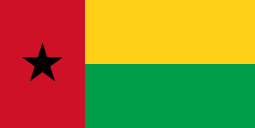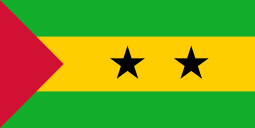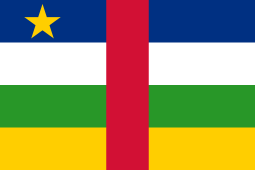Black Star of Africa
The Black Star of Africa is a black five-pointed star (★) symbolizing Africa in general and Ghana in particular. The Black Star Line, founded in 1919 by Marcus Garvey as part of the Back-to-Africa movement, modelled its name on that of the White Star Line, changing the colour from white to black to symbolise ownership by black people rather than white people. The black star became a symbol of Pan-Africanism and anti-colonialism. Described as the "Lodestar of African Freedom", the black star was used in 1957 by Theodosia Okoh in the design of the Flag of Ghana.[1]
Ghana
Ghanaians have come to regard the Black Star as a specific symbol of Ghana rather than of Africa in general.[2] As well as on the flag, the star appears on the coat of arms; on the Black Star Gate in Black Star Square in the capital, Accra;[1] and on the Seat of State in Parliament, on which the President sits on ceremonial occasions.[3] The Ghana national football team is nicknamed the "Black Stars".[4]
-
Black Star Gate, Accra
-

Civil air ensign of Ghana
-
.svg.png)
Flag of Ghana (1964–66)
Elsewhere
The Black Star was also in the flag of the African Party for the Independence of Guinea and Cape Verde (PAIGC) on which the Flag of Guinea-Bissau and the former Flag of Cape Verde were based. The Flag of São Tomé and Príncipe uses the same Pan-African colours with two black stars, one each for São Tomé and Príncipe.[5] The flag of the short-lived Union of African States had three black stars, one for each member state. Black Star Industries, named after the Black Star Line, is a commercial venture associated with the U.S. African People's Socialist Party.[6]
-

PAIGC flag
-

Roundel of the Guinea-Bissau air force
-
.svg.png)
Flag of Cape Verde (1975–92)
-
.svg.png)
Union of African States flag (1961–62)
Other stars
It is a common practice for an african country or countries in general to design their flag with some kind of star, as many countries do;[7] but this does not mean the same thing as the black star does. For example, white stars on flags- such as the Somalia flag- represent peace and unity for the nation, while the Black Star of Africa represents a kind of membership of Africa or African culture.
|
See also
References
Citations
- 1 2 Lentz 2008, p.11
- ↑ Lentz 2008, p.12. "Most contemporary Ghanaians, however, tend to interpret the Black Star as a uniquely Ghanaian symbol rather than one borrowed from an older pan-Africanist movement."
- ↑ Lentz 2008, pp.3,11
- ↑ Nimako, Kwame (2014-11-06). "Location and Social Thought in the Black : A Testimony to African Intellectual Tradition.". In Broeck, Sabine; Junker, Carsten. Postcoloniality - Decoloniality - Black Critique: Joints and Fissures. Campus Verlag. pp. 53–62: 58. ISBN 9783593501925. Retrieved 23 November 2015.
- ↑ Flag Institute (November 3, 2008). Complete Flags of the World. Dorling Kindersley Ltd. p. 91.
- ↑ "Black Star Industries". African People's Socialist Party. Retrieved 23 November 2015.
- ↑ "Star Flags - Flag Image Identifier". www.photius.com. Retrieved 2016-10-25.
Sources
- Crampton, William George (1993). "Marcus Garvey and the Rasta colours". Report of the 13th International Congress of Vexillology, Melbourne, 1989. Flag Society of Australia. pp. 169–180. ISBN 0-646-14343-3.
- "Country Comparison:Flag description". CIA World Factbook. Central Intelligence Agency. Retrieved 21 November 2015.
- Lentz, Carola (2008). "Travelling emblems of power: the Ghanaian 'Seat of State'" (PDF). Department of Anthropology and African Studies Working Papers (94). University of Mainz.







